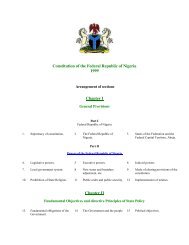Economic Recovery Growth Plan (ERGP) 2017-2020
This Medium Term Plan of the Federal Republic of Nigeria was designed to tackle the huge decline in the country’s economy since her shift from agriculture sector to crude oil and gas sector in the late 1960s. The plan’s objective includes restoring growth, investing in citizens and building a globally competitive economy.
This Medium Term Plan of the Federal Republic of Nigeria was designed to tackle the huge decline in the country’s economy since her shift from agriculture sector to crude oil and gas sector in the late 1960s. The plan’s objective includes restoring growth, investing in citizens and building a globally competitive economy.
Create successful ePaper yourself
Turn your PDF publications into a flip-book with our unique Google optimized e-Paper software.
Table 2.1: Three growth scenarios<br />
Scenario 1: Do nothing<br />
<strong>2017</strong> 2018 2019 <strong>2020</strong><br />
GDP growth (in per cent) -0.5 0.1 0.6 -0.5<br />
Per capita GDP (USD) 1315 1935 2,532 2,517<br />
Unemployment per cent 19.2 23.7 26.17 31.3<br />
Net job creation (million)<br />
Scenario 2: Introduce basic macroeconomic reforms<br />
- - - -<br />
GDP growth (in per cent) 0.6 1.6 3.2 3.8<br />
Per capita GDP (USD)<br />
1634 2138 2,673 2,764<br />
Unemployment per cent<br />
18.5 21.3 23.9 25.0<br />
Net job creation (million)<br />
0.5 1.1 1.1 1.3<br />
Scenario 3: Implement the <strong>ERGP</strong><br />
GDP growth (in per cent) 2.2 4.8 4.5 7.0<br />
Per capita GDP (USD)<br />
Unemployment per cent<br />
Net job creation (million)<br />
Source: MBNP and NBS<br />
2,542 2640 2,731 2,854<br />
16.32 14.51 12.90 11.23<br />
1.5 3.8 4.3 5.1<br />
Scenario 3 is the only viable option if Nigeria is to restore its economy to a path of sustainable and<br />
inclusive growth, create sufficient jobs to reduce unemployment and poverty, improve social inclusion,<br />
and remain on course to achieve international development targets, such as the UN SDGs.<br />
2.2 MACROECONOMIC FRAMEWORK<br />
Table 2.2 summarizes the projected macroeconomic indicators for 2016-<strong>2020</strong> under Scenario 3. To<br />
achieve the growth aspirations, the first requirement is a stable macroeconomic environment with low<br />
inflation, stable exchange rates and sustainable fiscal and external balances. This requires that the four<br />
main macroeconomic elements– the real sector, fiscal policy, monetary policy, and the external sector<br />
(balance of payments)– reflect the <strong>Plan</strong> and are all aligned and internally consistent.<br />
34





